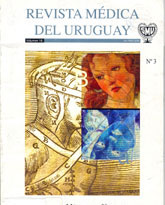Suppurative pericarditis and pericardic burst
A double exceptional complication in a serious polytraumathized
Keywords:
PERICARDITIS, PERICARDIAL EFFUSION, THORACIC INJURIES, WOUNDS BY A FIRE WEAPONAbstract
Pericarditis is defined as the inflammation of the pericardial serous membrane. Acute pericarditis may be due to numerous causes. Among them, trauma is a very infrequent cause. Purulent bacterial pericarditis is even less frequent (0,26%); it is seen as a complication following an extra cardiac infectious focus and it can be fatal if it is not rapidly treated. Early diagnosis is usually difficult and it may not be evident and if it evolves naturally it may not be evident until certain degree of cardiac tamponade occurs.
The case of a serious traumatized patient is reported. It presented numerous infectious foci and at the second week after hospitalization it developed a bacterial pericarditis with pericardiac burst followed by acute empyema and septic shock, and only intrasurgical diagnosis was possible.
This finding allows us to conclude that during the course of serious thoracic trauma it is necessary to determine the presence of fluid in the pericardic cavity and to evaluate the occurrence of suppuration related to the presence of systemic infectious foci and positive haemocul-tures.
References
2) Culliford A. Nonpenetrating cardiac trauma. In: Hood R, Boyd A, Cullinford A, eds. Thoracic Trauma. Philadelphia: WB Saunders, 1989: 211-23.
3) Glinz W. Injuries to the heart by blunt trauma. In: Glinz W. eds. Chest trauma. Diagnosis and management. Berlin: Springer-Verlag, 1981: 181-203.
4) Sigler L. Traumatic injury of the heart. Am Heart J 1945; 30: 459-62.
5) Klacsmann P, Bulkley B, Hutchins G. The changed spectrum of purulent pericarditis: an 86 year autopsy experience in 200 patients. Am J Med 1977; 63: 666-7e.
6) Van Vooren J, Thys J, Vanderhoeft P. Purulent pericarditis resulting from blunt chest trauma. J Thorac Cardiovasc Surg 1990; 100: 932-4.
7) Cheatham J, Grantham R, Peyton M. Haemophilus influenzae purulent pericarditis in children: diagnostic and therapeutic considerations. J Thorac Cardiovasc Surg 1980; 79: 933-6.
8) Morgan R, Stephenson L, Woolf P, Edie R, Edmunds L. Surgical treatment of purulent pericarditis in children. J Thorac Cardiovasc Surg 1983; 85: 527-31.
9) Sato T, Geary R, Ashbaugh D, Jurkovich G. Diagnosis and management of pericardial abscess in trauma patients. Am J Surg 1993; 165: 637-41.
10) Majid A, Omar A. Diagnosis and management of purulent pericarditis. J Thorac Cardiovasc Surg 1991; 102: 413-7.












